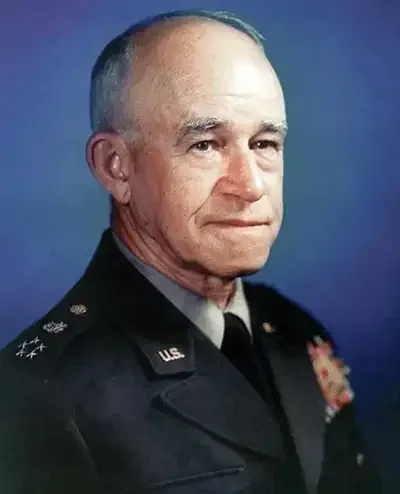- Military History
- Biographies
- Militarians Biographies
- General Omar Nelson Bradley
General Omar Nelson Bradley
Called "The G.I. General" because of his rapport with the common soldier, Bradley was one of the most effective American generals of World War ll
Bradley was Born in Clark, Missouri, and received an appointment to West Point, from which he graduated in 1915 with a commission as second lieutenant in the infantry. During 1915-18, he served in the West in a series of posts in Washington and Arizona and rose rapidly through the ranks, gaining promotion to major in June 1918. He was not shipped overseas during World War I.
At the end of the war, Bradley served as a military instructor at South Dakota State College (1919) and as an instructor at West Point from 1920 to 1924. He graduated from Infantry School at Fort Benning in 1925 and was posted to Hawaii from 1925 to 1928. In 1929, he graduated from the Command and General Staff School at Fort Leavenworth and was assigned as an instructor at the Infantry School during 1929-33. Bradley graduated from the Army War College in 1934 and became a tactical officer at West Point from 1934 to 1938, having been promoted to lieutenant colonel in June 1936.
In 1938, Bradley was appointed to the General Staff and promoted to brigadier general in February 1941. The following month, he was appointed commandant of the Infantry School, serving until February 1942, when he was put in command of the Eighty-Second Division (during March - June), and then the Twenty-Eighth Division (from June 1942 to January 1943).
After serving briefly as deputy to General Dwight D. Eisenhower from January to March 1943, he was named to replace General George S. Patton as commander of II Corps. Bradley led the corps during the final stages of the Tunisian campaign, capturing Bizerte on May 8, and leading II Corps during the Sicilian campaign from July 10 to August 17, when he was transferred to England to take part in planning what would become the D-Day invasion of France.
As lieutenant general, Bradley was named commander of the First Army in January 1944, which was assigned the right-wing position in the Allied D-Day landing at Normandy. Bradley planned and directed the key breakout at Normandy at Saint-Lo in July. The following month, he became commander of the 12th Army Group, comprising the First Army (under General Courtney L. Hodges) and the Third Army (under General Patton). In this capacity, he directed the southern wing of the massive Allied advance across northern France, which spanned August to December 1944. At 1.3 million men, the 12th Army Group was the greatest force ever commanded by an American general.
Promoted to four-star general in March 1945, Bradley continued in command of Twelfth Army Group during last operations in Germany from January to May 1945.
Following the war, Bradley was appointed head of the Veterans Administration, a post in which he served through December 1947. He then succeeded Eisenhower as CSA in February 1948 and became first chairman of the Joint Chiefs of Staff under the newly organized Defense Department during the Korean War. Bradley was promoted to general of the army in September 1950, and published his memoirs, A Soldier's Story, in 1951. He retired from the army in August 1953.
Bradley was not a brilliant tactician nor a brilliant strategist. He was, however, a powerful leader and, perhaps, the single most universally admired commander of World War II.
General Omar Nelson Bradley - Quick Facts
- 12th Army Group (United States)
- 1st Army (United States)
- 28th Infantry Division (United States)
- 82nd Division - Infantry & Airborne (United States)
- Chairman of the Joint Chiefs of Staff
- Chief of Staff (United States Army)
- II Corps (United States)
- United States Army Infantry School
- WWI (1914-1918)
- WWII (1939-1945)
- Cold War (1947-1991)
- Korean War (1950-1953)
- {{#owner}}
- {{#url}} {{#avatarSrc}}
{{name}} {{/url}} {{^url}} {{#avatar}} {{& avatar}} {{/avatar}} {{name}} {{/url}} - {{/owner}} {{#created}}
- {{created}} {{/created}}
























